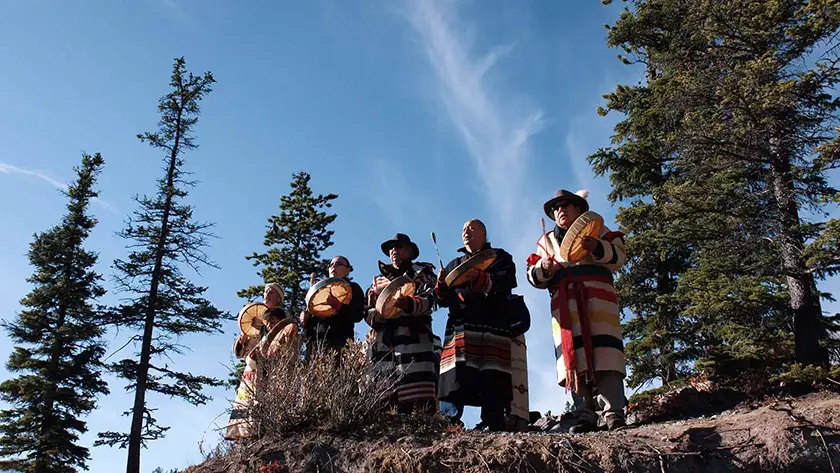Singing Back the Buffalo shows the push for reclamation of Native identity as well as highlighting the responsibility we all share with our environment.
Director: Tasha Hubbard
Genre: Documentary
Run Time: 98′
imagineNATIVE Screening: June 5-15, 2025
U.S. Release Date: TBA
U.K. Release Date: TBA
Canadian Release Date: September 13, 2024
Where to watch: Out now in theaters across Canada
Singing Back the Buffalo is one of the highlights of the ongoing imagineNATIVE film festival. It shows an important subject unique to Indigenous American life and gives a unique perspective on the story. While the plight of the American bison (also known as the buffalo) is well documented, there is little coverage on how the species is surviving in the present day. Director Tasha Hubbard tells the story from a firsthand perspective of how many North American tribes have banded together to save this great animal, and with it part of their culture. It is a fascinating tale which will enchant anyone with even a passing knowledge of these creatures.
The American buffalo once roamed the entire continent from coast to coast. During periods of European settlement, their numbers dropped from the millions to only a few thousand in scattered herds across the center of the continent. Tribal elders depended upon the buffalo for food and shelter, following the herds across the plains, and the native tribes began to decline with the buffalo. It was said the buffalo would return when the people started singing for them, so that is what Tasha Hubbard is doing with the film. In singing for the buffalo, people tried to help them come back.
It has been suggested humans, as the highest intelligent lifeform, must be the stewards of the Earth. The loss of the buffalo signals a failure in that mission. Without the buffalo, vegetation ran wild, and the soil became less fertile with less plant variety. Alongside humans, other creatures which depended upon the buffalo, like wolves, began to vanish. Even though buffalo numbers recovered, many herds to this day are still in private ownership or interbred with domestic cattle. The only truly wild herd left are the Yellowstone buffalo, who number about five thousand strong, which is still not ideal numbers for the once numerous creatures. If the wilds of America seem more empty now, it is because humans made them that way.

Even international border disputes have been affected by the buffalo. The Salish and Kootenai tribe of northern Montana maintained and followed a herd for their sustenance, but when the United States and Canada drew their border, the tribal residents were left on the Montana side while the buffalo were placed on the Canada side, and kept on a range for the sake of their own preservation and westward expansion. The buffalo were spared extinction, but lost their freedom as a wild species.
Singing Back the Buffalo presents an element of unity among disparate people. The plight of the buffalo was enough to unite thirteen tribes across eight reservations in two countries to sign the first Buffalo Treaty in 2014. These people had little in common in terms of culture and language, but they all depended on the buffalo, and had to work together to save it. Millions of acres were now devoted to buffaloes across the nation, including reintroduction to places like Banff National Forest where they had been pushed away from. Cooperation and community helped to make a difference, as is the case with any environmental issue.
Tasha Hubbard narrates the tale with respect and honesty. Even though her voice may not be the most engaging for documentary narration, it is still a great story and worth hearing for everyone. These creatures are a way of life for many people, and losing them means losing their culture. Every part of the buffalo is used in their daily lives, with nothing going to waste. Each buffalo is treated with respect and given proper dignity in its slaughter, rather than overhunting and commercial farming of modern beef. Animations are used to tell stories of human encounters with buffalo and dramatize unique tales of man and nature never caught on film. It adds to the mystical, almost supernatural status these animals have in Native culture.
Singing Back the Buffalo is about the intersection between the environment and human activity. As humanity advances as a species, other creatures are pushed away and disrupted. Only we have the choice on which creatures live or die in this changing world. The buffalo are valued alive by indigenous tribes, so it is only fair they fight to save them. With this documentary, many others may be swayed to try as well.
Singing Back the Buffalo (imagineNATIVE): Movie Plot & Recap
Synopsis:
Indigenous tribes unite to return the buffalo to the wild both to save the species from extinction and reclaim a part of their culture.
Pros:
- Covers a lesser known topic in great detail
- Animations help to tell the story in a more digestible way
- Raises awareness for its main issue successfully
Cons:
- Tasha Hubbard’s narration is a little dry
Singing Back the Buffalo will be screened in person at imagineNATIVE on June 5, 2025 and will be available to stream online worldwide on the festival plaform on June 9-15. The film is out now in theaters across Canada.

